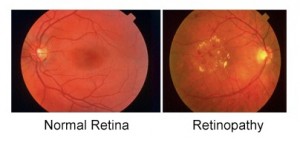Diabetic Eye Disease Doctors in Brooklyn, NY
Drs Millie Fell and Andrew Brookner are ophthalmologists in Brooklyn, specializing in diagnosing and treating diabetic retinal disease, known as diabetic retinopathy. This condition is treated with laser therapy and intravitreal injections. For your comfort, laser treatment is performed in our state-of-the-art office. Both doctors routinely administer steroid and anti-VEGF medications such as Avastin, Lucentis, and Eyelea to patients requiring these miraculous vision-saving drugs.
What Is Diabetic Retinal Disease?
 Diabetics are more susceptible to diabetic retinal disease because of their fluctuating blood sugar levels. High sugar levels in the blood damage blood vessels throughout the entire body, including your eye. In particular, high blood glucose levels cause damage to the blood vessels in the retina of the eye. The retina lines the back of your eye like wallpaper, and is like the film in a camera—it detects the light entering your eye and turns it into pictures for your brain to see. When the retina’s blood vessels are damaged, the retina stops working properly, and sight can be lost.
Diabetics are more susceptible to diabetic retinal disease because of their fluctuating blood sugar levels. High sugar levels in the blood damage blood vessels throughout the entire body, including your eye. In particular, high blood glucose levels cause damage to the blood vessels in the retina of the eye. The retina lines the back of your eye like wallpaper, and is like the film in a camera—it detects the light entering your eye and turns it into pictures for your brain to see. When the retina’s blood vessels are damaged, the retina stops working properly, and sight can be lost.
After being exposed to high sugar levels for a long time, the blood vessels in the retina develop some weak spots. These weak spots often pooch out like bubbles along the blood vessels, and these are called microaneurysms. Sometimes, the microaneurysms rupture, and blood spills in the retina to form small dot hemorrhages. Your retina will eventually clear the blood away, but some debris is often left behind—these clumps of debris are called hard exudates. Altogether, these changes—microaneurysms, dot hemorrhages, and hard exudates—are called background diabetic eye disease. The fluid that remains in the center of the retina, the macula, is called diabetic macular edema. The macula is the central part of the retina that is responsible for near or reading vision.
What Are the Symptoms?
Background and early proliferative diabetic retinopathy have few to no symptoms. Early indications of the disease may include floaters, blurriness, dark areas of vision, and difficulty perceiving colors. Blindness can occur. In fact, diabetic macular edema (DME) is the leading cause of blindness in working Americans age 40 to 60. The only way to know if you have these changes and need laser therapy or intravitreal injections is to visit your eye specialist. Brighton Eye Ophthalmology Center recommends that people with diabetes have their eyes examined at least once a year to assure that they do not have early decay that threatens their vision. If it is caught early, before the vision is damaged, both background and proliferative diabetic eye disease can be treated. These conditions can also cause irreversible vision loss.
How Is it Diagnosed?
Diabetic retinopathy is diagnosed by a dilated retinal exam by a trained specialist. In our office, we also have high tech digital tests that help in the diagnosis and treatment of these conditions. These tests include fluorescein angiography and Optical Coherent Tomography or OCT.
During Fluorescein Angiography, a yellow vegetable dye is injected into a vein in the arm. This dye circulates to the back of the eye. Photographs are taken of the retina to detect the extent of the diabetic disease and to guide laser treatment or treatment with Intravitreal Injections.
Ocular Coherent Tomography or OCT is a non-invasive imaging test that uses light waves to take cross-section pictures of the retina. With OCT, each of the retina’s distinctive layers can be imaged and their thickness measured. This allows the doctor diagnose retinal conditions and guide treatment.
Treatment and How We Can Help
Both Doctors Fell and Brookner are fellowship-trained diabetic eye specialists. They both perform laser treatment on patients with diabetic eye disease and administer intravitreal injections. The laser is used to close bleeding or leaking blood vessels. Sometimes laser treatment is applied to stabilize the retina and cause abnormal blood vessels, called proliferative neovascularization which tend to bleed more easily, to disappear. The intravitreal injections utile one of the anti-VEGF drugs and are helpful in decreasing macular edema and retinal bleeding.
Dr. Fell is a board-certified ophthalmologist and has performed thousands of eye surgeries and laser treatments. Her extensive experience has earned her entry into Fellow in the American College of Surgeons (FACS). She is an assistant clinical professor of ophthalmology at NYU Medical Center and assists the ophthalmology residents in the OR with cataract surgery.
Dr. Brookner is a board-certified ophthalmologist who has performed thousands of eye surgeries and laser treatments. He has worked in other practices as a retinal specialist.
Both Drs. Fell and Brookner are fellowship-trained in medical diseases of the retina.
Drs. Fell and Brookner and their staff are highly trained professionals ready to help patients with this condition.
For more information about us, or to schedule an appointment, call (718) 339-6868 or complete the online form.

